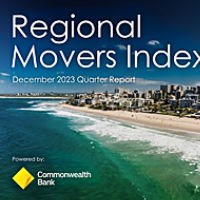“Regional Australia has become the nation’s new frontier. This analysis is clearly showing the population movement we’re seeing is a sustained new trend, that is higher than pre-Covid migration patterns. The regional Australia we have now, is quite different to the regional Australia of five years ago,” Ms Ritchie said.
“The emergence of this new era signifies how important the regions are to the future of our nation. The regions will be at the heart of Australia’s net zero transition, and it is vital the infrastructure and services our growing regions require are met to ensure long-term prosperity and sustainability of our country.”
The data shows despite a seasonal dip in overall movement across the country in the June quarter, the Australian population remains highly mobile, with city-to-regional relocations tracking 16 per cent above the pre-Covid average, and regional-to-regional relocations 10 per cent above.
The RMI is a partnership between the Commonwealth Bank of Australia (CBA) and the Regional Australia Institute (RAI), which analyses quarterly and annual trends in people moving to and from Australia’s regional areas.
CBA’s Executive General Manager Regional and Agribusiness Paul Fowler said: “Australia’s love for regional Australia shows no sign of slowing down, as movers from metro areas continue to reap the lifestyle and economic rewards of life in the regions.
“While the June quarter typically sees a drop in relocations, this quarter saw the smallest decline we’ve ever seen, highlighting the potential for a new era of year-round relocations.”
The latest report also shows the emergence of new regional hotspots, with Lake Macquarie, north of the NSW Central Coast, one of Australia’s most popular destinations for movers, securing an almost 5 per cent share of net internal migration over the past year. When it came to growth hotspots, the neighbouring NSW South Coast Local Government Areas (LGAs) of Bega Valley and Eurobodalla both experienced strong annual and quarterly surges in movement.
Mr Fowler said: “The coastal appeal of regional hubs like Lake Macquarie, Bega Valley and Eurobodalla offer an attractive lifestyle with convenient access to quality healthcare and education services, as well as employment opportunities, further bolstered by major industry investments like the Snowy Hydro 2.0 project in Southern NSW.”
New analysis this quarter also provides valuable insights on movement on a state-by-state basis, with the top five LGAs by share and growth in net internal migration revealed across the country.
While large centres within a few hours’ drive of capitals remain popular with many movers, regions experiencing the most growth over the last 12 months were generally further afield, including Townsville (Qld), Mid-West Regional (NSW), Strathbogie (Vic), Murray Bridge (SA) and Greater Geraldton (WA).
Ms Ritchie said around three-quarters of city dwellers who made the move to the regions in the past three months had settled in either regional New South Wales or Victoria, reflective of capital city net migration data which shows Sydney, and to a lesser extent Melbourne, continue to shed the largest number of people.
“With so many people settling in our southern states, it’s critical governments, industry, business and community work together on ensuring regional cities and towns are supported during this phase of expansion. The regions provide so much: affordability, a sense of community, fulfilling career options and green space. Let’s ensure this new era of regionality is met with vision and leadership to drive a more decentralised Australia,” Ms Ritchie said.
Regional Queensland’s share of net city outflows fell to 19 per cent in the 12 months to June 2024, down from 41 per cent in the year prior. The Sunshine Coast retained its title as the nation’s most popular destination for movers, accounting for a 14 per cent share of net internal migration, however the Gold Coast slipped down in ranking on account of experiencing a net outflow of people to other regional areas, suggesting it’s fast becoming a gateway to more remote and rural areas of the country.
Mr Fowler said it was far from an east-coast story though, with Albany, Bunbury, Busselton, Capel and Northam in Western Australia all making various hotspot lists.
“Western Australia’s vibrant economy can be felt across the state, with the southwestern corner becoming a major drawcard for both city-dwellers and region-to-region movers. The introduction of initiatives like the state’s Government Regional Officer Housing Program are among the contributing factors that have accelerated this growth.
“The continued inflows we’re seeing into the regions like these hotspots of Western Australia, show the appeal among Australians seeking a sea or tree change, and offer even greater opportunity for industry and businesses alike who are eager to capitalise on this growth,” said Mr Fowler.



